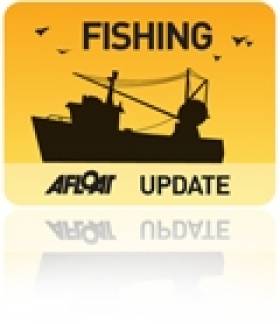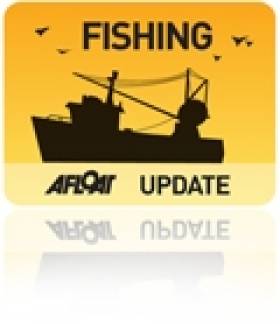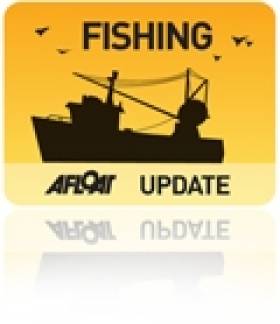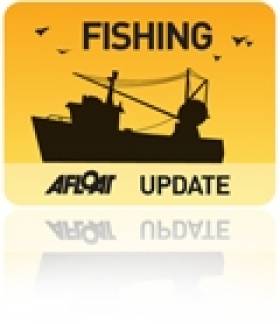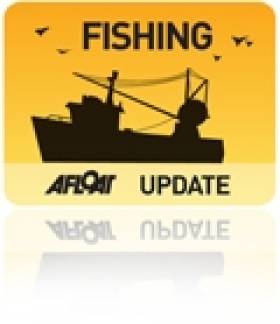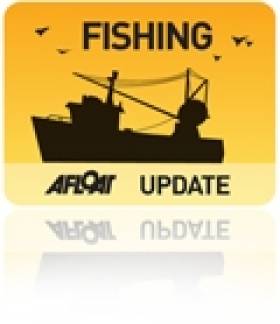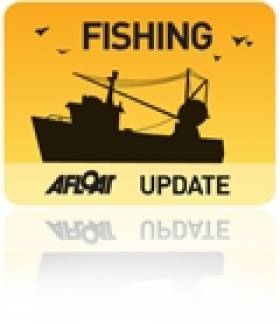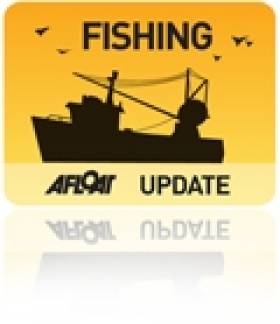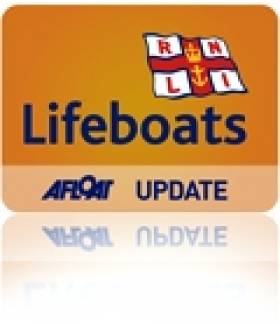Displaying items by tag: Fishing
Former Obama Adviser sees a "Rebirth" in the Use of Industry Information to Guide Scientists
Dr. Peter Heffernan (Marine Institute) with Martin Pastoors (IMARES, The Netherlands) and Dr. Steve Murawski (NOAA, USA) at the Conference. (Photo: Marine Institute).
The Conference - "Fisheries Independent Information, Galway 2010" – not only explores how information gathered at sea by fishermen can better contribute to fish stock assessments, management and policy but critically, how the vast amount of experience and traditional knowledge accumulated by the fishing industry can be harnessed in sustainable management strategies.
Speaking on the first day of the event Dr. Steve Morawski, former senior advisor for the National Oceanic and Atmospheric Administration to President Obama's Ocean Policy Task Force and the current Chief Science Advisor to NOAA Fisheries, USA said that in spite of past concerns regarding the reliability of fishery-dependent data, we are in the midst of a "rebirth" in the use of information from industry to inform stock assessment and the management of catch and by-catch allowances.
"Fortunately, great advances have been made in methods for collection and analysis of fishery-dependent data and we have experienced encouraging success in working with stakeholders to collect this type of data," he said.
Some 30 countries from across the globe are represented at the conference, which features 81 oral presentations and 50 poster displays covering the entire spectrum of fishing, from small scale artisinal fisheries right up to large scale industrial operations engaged across the world's oceans and inland waters.
Opening the conference, Dr. Peter Heffernan of the Marine Institute said that, while Ireland had made significant progress in bringing scientists and fishers together through the formation of the Irish Fisheries Science Partnership, he was keen to learn how such initiatives had worked elsewhere and what we could learn from others. "Innovation is the key element to this conference," he said, "technical innovation in the development of new data collection tools and data integration, but also through innovative thinking and co-operation in how we can marry together traditional and non-traditional information."
According to the International Labour Organisation (ILO) the capture fishing industry employs some 27 million people worldwide (including full-time, part-time and occasional fishers). In Europe, the European Commission estimates that some 141,000 people are employed in the fishing sector which produces over 6.5 million tonnes of fish between the catching and aquaculture industries.
"Fishermen and scientists have an enormous amount that they can contribute to each other," said Lorcan O'Cinneide, CEO of the Irish Fish Producers Organisation in his keynote address earlier today (Tuesday 24th August). "It is essential for the future that the integration of such information can be brought to the centre of the scientific and advice process in a manner that has the necessary rigour to be credible and useful to analysis."
Marine and inland fisheries are of particular importance to developing countries where ILO estimates that over 94% of the world's fishers live (Asia 83%, Africa 9% and South America 2.5%). In these countries fish is not only an important source of protein for many communities, but also an important part of global trade. The role that fishers and their knowledge play in ensuring a sustainable "ecosystem approach" to commercial fishing by artisinal and small-scale fishworkers the world over will be discussed during the last day of the Conference (Thursday 26th) by Sebastian Mathew of the International Collective in Support of Fishworkers (ICSF).
The conclusion of his paper will suggest that sustainability in fisheries depends upon seeking common ground between fisheries policy, scientific knowledge and fishers' knowledge and practice. He will also suggest that the key to sustainable fisheries management lies in treating fishers' knowledge with respect and by promoting active communication amongst stakeholders.
Sea-Fisheries Protection Authority's "Guide to Compliance for the Irish Inshore Fleet" is Launched
Minister Séan Connick TD, Minister of State at the Department of Agriculture, Fisheries and Food (with special responsibility for Fisheries and Forestry) launched the Sea-Fisheries Protection Authority's (SFPA's) "Guide to Compliance for the Irish Inshore Fleet", today, Wednesday 28th July, at an event organised on board the LE Eithne at Galway Docks. The "Guide to Compliance for the Irish Inshore Fleet" is a concise guide that summarises the principal requirements that apply to Irish fishing vessels under 15 meters operating in Irish inshore waters.
The guide was developed through ongoing cooperation between the SFPA and the Irish South and East Fish Producers Association, the Kilmore Quay Harbour Users Group in conjunction with the Ministerial appointed Sea-Fisheries Protection Authority Consultative Committee and other industry stakeholders. The intention of the project was to provide a clear concise guide to the various technical regulations that apply to inshore fishing activities in a user-friendly format. The provision of good information to stakeholders is a key element of the SFPA's compliance strategy and this guide supports the SFPA and Industry in their work towards building a culture of compliance.
The guide does not purport to represent a detailed legal interpretation of the legislation however it does consolidate in one user-friendly document the main requirements which apply to Irish vessels fishing in Irish inshore waters. It addresses areas such as quota restrictions, boat markings, gear requirements, authorisations, sales notes, transport documents, marine protected areas, fishing restrictions, hail requirements, effort recording, effort reporting, minimum sizes and food safety. This comprehensive guide will also help fishermen navigate the paperwork that goes with fishing including completion of the fishing logbook and the registration of the fish after landing. The guide is produced on water proof and tear resistant paper suitable for use on board inshore fishing vessels and will be distributed to all inshore fishermen by the SFPA.
Peter Whelan, Chairman of the SFPA, said: "The production of this guide is a very positive development and had been widely supported by the fishing Industry Representatives and the Consultative Committee. This partnership approach benefits both the fishing industry and the SFPA and underpins the day-to-day efforts of fishermen to protect their livelihoods by complying with legislation that conserves fishing stocks for long-term sustainable exploitation. It is consistent with our legal remit to promote compliance with and deter contraventions of sea-fisheries law and food safety law. The SFPA are very pleased with the strong move towards compliance being demonstrated by the Irish Fishing Industry and this guide aims to support that move."
Minister for Agriculture, Fisheries and Food Brendan Smith TD and Minister of State with responsibility for Fisheries, Sean Connick TD, today launched Bord Iascaigh Mhara's (BIM's) new three year strategy (2010 – 2012) and the Irish Seafood National Programme to 2013. The event, which was hosted by BIM at the decentralised Department and BIM offices in Clonakilty, was attended by a large audience from the wider seafood sector.
In his address, Minister Smith welcomed the opportunity to launch these two significant initiatives acknowledging how appropriate it was that they come on the same week as the launch of Food Harvest 2020, which focused on the contribution to be made by the food sector generally in Ireland's economic recovery.
Minister Smith said that both he and Minister Connick attached "a high level of importance on BIM's transformation agenda for the seafood sector and on the associated seafood development measures contained in the Seafood National Programme".
BIM's new strategy document concentrates on avenues to deliver essential developmental services to a seafood industry undergoing rapid and unparalleled change. The Minister commended BIM for clearly setting out challenging targets for themselves for delivery by 2012, including the creation of 600 jobs, an additional €50m in value added seafood sales, and greater differentiation of 40,000 tonnes of Irish seafood products worth €120m.
Minister Smith went on to say "I have consistently stated that the seafood sector, made up as it is of indigenous operators, will have a significant role to play in Ireland's economic recovery. BIM's new strategy is a welcome addition to the suite of harmonised strategies for the seafood sector including Steering a New Course, Sea Change, as well as Food Harvest 2020. It adds to and fully complements the existing strategies and positions Ireland well to maximise the very large opportunities which are presenting themselves in the international seafood markets".
Focusing on the National Programme for the development of the Seafood Sector, Minister of State Connick said "The measures contained in this Programme are the tools to enable the Government and its agencies deliver on the objectives contained in the suite of Seafood focused strategies, and places Ireland in a promising position to capture some of the undoubted opportunities which are emerging in both the international and domestic seafood markets".
Minister Connick said that the proposed investments in the seafood industry constitute a significant vote of confidence by the Government in the sector. He went on to say "The programme published today envisages a significant state investment into the Irish seafood sector from now until the end of 2013. A dedicated allocation of €6.5m is being made available for the remainder of 2010 for the development of the aquaculture and processing sectors." While the programme also facilitates access to other funding from Bord Bia for marketing, from Enterprise Ireland for processing, and from BIM for added value and innovation and fisheries support".
On the launch of the two initiatives Minister Connick said "The launch of these two complementary initiatives to drive forward the development of a modern, high value added, sustainable and expanding seafood sector is an important event in delivering the real opportunities which exist for income generation and enhanced employment in our coastal communities".
New RTE Documentary Series on Irish Fisherman
RTE turns its cameras on Ireland's fishermen in a six-part series starting this Sunday on RTE One. Skippers takes the Irish audience aboard working fishing vessels in the Irish fleet to meet the men who lead these boats; the Skippers.
Crews in pursuit of their lucrative catch, involving long absences from home, 24 hour shifts, huge waves, 80-mile-per-hour gales, and the unpredictability that is the ocean itself are part-and-parcel with this job.
The series was shot by DV Directors who ate, slept, breathed and fished with our Skippers while they were out on the high seas in the world's most dangerous job, creating a sense of immediacy with the audience at home; bringing the action, and turmoil wave by wave, roll by roll. Visually stunning images of the Irish coastline and sea wildlife, along with the roaring ocean will compliment the strong-character presence of our Skippers and their crews, with the illusive lights of home becoming a beacon in the night for the Skippers as they make their way ashore after their gruelling trips.
In the first episode, two former construction workers try to make a go of it at sea, a fisherman's wife tells her story, and a mystery fish causes havoc for a trawler crew and a rookie skipper feels the pressure to make the grade.
THE SKIPPERS
DAVID PRICE:
Howth in North County Dublin is home to the Price fishing family and youngest son David is carrying on the tradition as an energetic skipper on his fathers 60 foot, €2 million trawler "The John B". David is fishing 80 miles off the east coast of Ireland in search of prawns. Times have changed for David as he has to work twice as hard as he did five years ago when he used to sell his prawns for double what he's getting for them today.
David is frustrated with regulations that make little sense. He has to throw away perfectly good fish due to quotas. The pressure of costs versus the price he is receiving for his catch is not adding up and this frustration is sometimes taken out on his crew.
The collapse of the building industry has meant that some Irish are looking at fishing again for work. This trip has brought on board two former construction workers John and Emmet who both want to make a go of it in the fishing business. For John it's a big change from his previous job as a plumber but he's hoping he won't have to be fishing for too long.
This trip will be make or break for the two Irish lads as David has to decide if they are cut out for the hard life at sea.
His training is tough and they won't be getting any special treatment.
ROSS CLASSON:
Portnoo in Donegal is home to 42-year-old skipper Ross Classon. He's been fishing since he was 15. But Ross has no family background in the industry and is the son of a school principal. He went to sea purely because he loved it. This comes with a price to pay as he has less time to spend on shore with his family, when he does come home it is not long before Ross has to leave again.
His wife of 25 years, Anna, remembers the strain of bringing up their sons while Ross was out at sea. Anna has learned to deal with not seeing Ross for weeks at a time, she's learned to cope but she knows other families who haven't found things so easy. Ross's boat is based in Ullapool, Northern Scotland. He has to make the 430 mile journey by road and sea.
MICHAEL MEADE:
60 miles off the south coast of Cork is skipper Michael Meade. He's been fishing for the past 25 years and has owned his trawler the Buddy M for the past 10 years. Along side Michael are four regular crew members including Brendan from Cork and Sergey from Warsaw. Michael has seen the fishing industry slowly being eroded and is not too hopeful for the future. He fishes out from the small port of Cross haven in Cork.
CATHAL O'SULLIVAN
The old fishing village of Castletownbere in Co. Cork is where the ambitious and determined Cathal O'Sullivan is based. Cathal has no background in fishing and originally comes from Kenmare in Kerry. He started fishing at 16 and now at 24 is one of Ireland's youngest skippers in charge of the 40foot trawler the Tea Rose. This €1 million boat is owned by Paddy O'Sullivan who has recently put his faith in Cathal to go it alone.
Cathal leaves behind a young family, his son gets upset each time Cathal leaves , but Cathal's duration at sea is getting longer due to the rising price of fuel and the decrease in the value of his catch. He often will do three fishing trips in a row leaving his family for up to 20 days at a time. With every trip comes the pressure of finding a good catch for the crew in order for himself and his men to earn a decent wage
Connick Opens Fish Ireland 2010
Sean Connick TD, Minister of State at the Department of Agriculture, Fisheries and Food, today opened Fish Ireland 2010, Ireland’s trade exhibition for the Irish Fishing Industry. Minister Connick also took the opportunity to meet with representatives of the Killybegs Fisherman’s Organisation and the Donegal fish processing companies to continue the ongoing dialogue on issues facing the fishing sector.
The Minister welcomed the invitation to open the exhibition and noted the appropriateness of holding such an event in Killybegs, one of the most modern fishing ports in the EU. On the exhibition which was organised by the Marine Times the Minister said “Events like this allow fishermen and their suppliers discuss the ever changing needs of the industry and prepare for future requirements”. He went on to say that further measures for sustainable fishing practices on the horizon required that “a more flexible approach will have to be adopted, not only by the fishermen but also by the suppliers of the fishing industry”.
In his address Minister Connick touched on a number of topics including the reform of the Common Fisheries Policy, however, his central message revolved around innovation, differentiation of product and maximising returns. He complimented the fishermen and processors in Killybegs for being “To the forefront in innovation, diversification and forward thinking, playing a large part in driving the further development of pelagic markets, particularly in Russia, and the move towards more processing of Blue Whiting for human consumption”.
He also referred to the foresight of the KFO in funding research into the sustainability of a new boar fish fishery saying “This is an exciting departure and one which shows how serious we in Ireland are about conducting our business in a proper and prudent manner mindful of the finite nature of the resource we harvest”. The Minister emphasised the integral part the seafood industry will have to play in Ireland’s economic recovery, saying “We have a high quality raw material on our doorstep, we have a flexible and innovative industry and the demand for our product remains strong. What we must do is continue to innovate, differentiate Irish seafood and maximise our returns by increasing value added”.
He went on to encourage processors to avail of the services BIM’s Seafood Development Centre. Saying “This world class facility can only benefit companies who want to be progressive and grow their markets. It is already assisting 60 Irish seafood companies to differentiate and further refine their products since its launch in October last year and is well on its way to delivering its ambitious target of €100 million in additional value added sales over the next five years”.
Spanish Fisherman Fined for Illegal Fishing Activity
The Master of a Spanish fishing vessel, the ‘Nuevo Murgados ‘ was fined and had his catch and gear confiscated by the State in a case brought before Cork Circuit Court on Tuesday 15th June 2010. Fines of €20,000 in total were imposed and forfeiture for the catch and gear amounted to €41,000. The Judge also imposed an award of €5,000 towards costs of the case. The case was the subject of a trial brought before Cork Circuit Court between the 29th of April to the 5th May 2010 whereby the defence sought to challenge the use of the new Omega Gauge in the measurement of nets.
The ‘Nuevo Murgados’ was boarded by the Naval Service off the West Coast of Ireland on the 28th September 2009, and was subsequently inspected by Sea-Fisheries Protection Officers (SFPOs). During the inspection, two nets were measured by the SFPOs using the Omega Gauge; the results were that nets were found to be 93.8mm and 77mm respectively which contravened EU regulation. The Master was charged with two offences including; logbook infringements -operating a net of less than 100mm whereas 100mm was recorded in the EU Logbook and retaining in excess of 20% Hake while operating a net between 55mm and 99mm.
On the 1st September 2009 the Omega Gauge was introduced as the definitive means for the measurement of the mesh size of fishing vessels operating in community waters. The Omega Gauge applies a predetermined force and calculates the average for a series of measurements ensuring consistency in measurement, whereas the preceding gauge required the inspector to apply a manual force.
Peter Whelan, Chairman of the SFPA said: “The defence in this case challenged the Omega Gauge, and in this context securing a conviction was significant. The use of the Omega Gauge has been the subject of some criticism however the outcome of this case proves the viability of the system. The Omega Gauge will provide a consistent reliable measurement for fishermen and should provide assurance for legitimate operators that the same result will be produced whenever their gear is measured. The Omega Gauge improves the methodology for mesh size measurement which will contribute to better implementation of technical conservation measures and the effectiveness of fishery management overall.”
New Safety Scheme for Irish Fishermen
Minister of State at the Department of Agriculture, Fisheries and Food, Sean Connick, T.D. has formally launched a new programme of financial support to assist fishermen upgrade critical life-saving, fire-fighting, and other safety equipment on-board their fishing boats.
The delivery of the scheme is projected to provide up to €3 million of funding over the next five years, subject to budgetary provisions. The scheme will be administered by Bord Iascaigh Mhara (BIM), the Irish Sea Fisheries Board. In addition to fishing boats, the scheme also provides for the purchase of 'on-board' safety equipment for registered vessels used for sea-angling and other forms of marine tourism.
Speaking at the launch in Wexford, Minister Connick explained the importance of this timely scheme. "I am only too aware of the pain and suffering that is caused to the families and our coastal communities as a result of accidents at sea. We were unfortunately reminded of the dangers of the sea again this weekend with the news of the accident off Helvic Head yesterday. It is imperative that we do all in our power to prevent further accidents and especially casualties and one of these preventative measures includes ensuring our fishing fleet is operating to the best safety standards. This new scheme will enable up to 800 vessels to modernise their onboard safety equipment to further protect fishing crew. However, it is not enough to have a modern vessel, all skippers and crew must complete basic safety training and I would encourage all fishermen, who have not already done so, to contact BIM to complete their safety training without delay".
The Fleet Safety Scheme is an integral part of the 2007-2013 National Development Plan - Sea Fisheries Development Programme and is intended to further improve the overall safety standards onboard Irish fishing vessels. Under the previous Fishing Fleet Development Measure 2000-2006, 1,234 vessels availed of assistance under the Fleet Safety scheme and received grant aid of €2.23 million in support of €5.57 million investment. The current scheme which will run from 2010-2015 will provide grant aid of up to 40% for the purchase and installation of safety items including statutory lifesaving, fire-fighting, navigation and communication equipment.
Rose McHugh, Chair of BIM in welcoming the Minister's announcement said "On behalf of BIM, I would like to thank Minister Connick for his support and approval of this important scheme. Safety is paramount for the Irish fishing industry and this package will help fishermen in these difficult times to modernise their vessels in line with safety standards which will ultimately help to save lives at sea".
Applications and details on the Fleet Safety Scheme and the three other schemes under the Sea Fisheries Development Programme are available from www.bim.ie
Commission Launches Discussion on 2011 catch levels
Catch limits for the Baltic Sea, the Black Sea and the North-East Atlantic (including the North Sea) are set annually by fisheries ministers following proposals by the Commission in the autumn. Quotas for deep-sea species are set every two years.
The Commissioner would like to see a tougher method applied to setting quotas and days at sea, in order to meet international standards. While launching the report the Mrs Damanaki said, "I want to be clear that the quota levels set must respect all the European Union's commitments to sustainability, our commitments to nearby States, and the commitments we have made under long-term plans."
EU Member States agreed in 2002 that fish stocks should only be exploited to their maximum sustainable level. This policy is having results with 11 stocks meeting this target.
Annually, the Commission drafts a report on fishing stocks to explain to the fishing industry the rules that will be used to set quotas. Common rules ensure that all fleets are treated equally and fairly. The EU fisheries policy must be guided by the following parameters; environmental sustainability; stability in quotas when possible; respect for international commitments; the reduction in over-fishing and the rebuilding of stocks; usage of international consensus scientific advice. Overall the Commission will practice caution when there is uncertainty.
The Commission relies on scientific advice from two international expert committees when proposing fish quotas: the International Council for the Exploration of the Sea, based in Copenhagen and the Scientific, Technical and Economic Committee for Fisheries. This advice will be available in June/July.
The Commission will now send the report to the fishing industry and Member State Governments for consultation and examination. After taking account of their responses a final strategy proposal will be made.
Lifeboats Rescue Man Overboard off Antrim Coast
On a busy Sunday for RNLI lifeboat crews off the north Antrim Coast both Red Bay and Portrush RNLI lifeboat crews launched at 9.22am this morning to reports of a vessel in difficulty with two people onboard off Sheep Island at Ballintoy.
The 16 foot fishing boat got into difficulties when an anchor went down and a crewmember from the vessel bent over the bow of the boat in an attempt to retrieve it. He was caught by a wave and pulled into the freezing water.
When the lifeboats arrived on scene the man had been recovered onto the vessel by the other crewmember. Conditions were poor with a force five in evidence and a big swell. Both men were suffering from the cold and were in shock. The vessel was clearly in great difficulty and the two men were transferred onboard the Portrush all weather lifeboat while Red Bay RNLI towed the vessel back to land. A waiting ambulance met the casualties at Ballycastle.
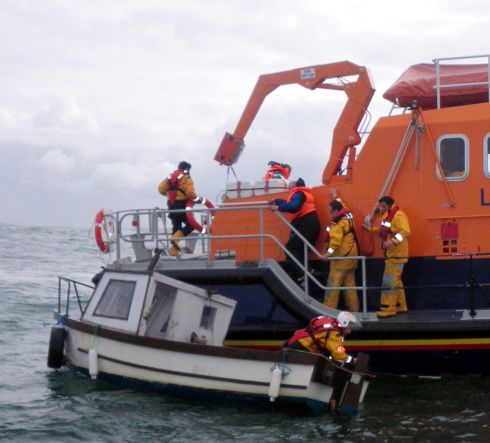
Commenting on the rescue Red Bay RNLI helm Paddy McLaughlin said, “These two men were extremely lucky today. One man had already entered the freezing water before getting back on the boat and they were both in need of medical assistance by the time we had reached them.”
The rescue operation lasted for three hours and was the second major rescue for the RNLI in the area that morning. Portrush RNLI inshore lifeboat crew rescued two men from the sea while their all weather lifeboat assisted Red Bay with the Ballintoy callout.
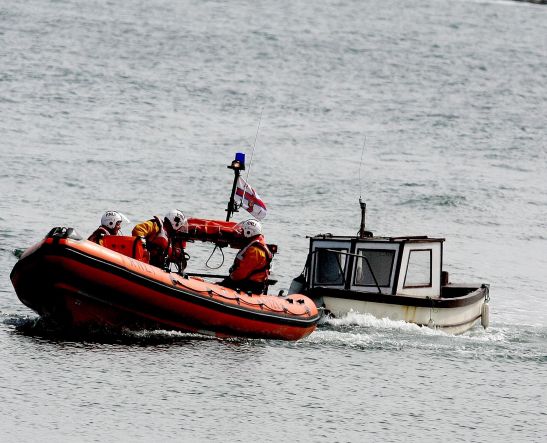
Additional report from MCA:
The emergency 999 call was made at 9.15 this morning alerting the marine emergency service and that the cruiser with two people on board was in extreme difficulty and without power.
The Coastguard immediately relayed a mayday signal into the area to alert other vessels to the on going emergency.
The Portrush and Redbay lifeboats were also asked to launch and a rescue helicopter was initially scrambled from the Royal Naval Air Station at Prestwick, however by this time the man had been recovered to the vessel and it was stood down. His colleagues on board the cabin cruiser indicated that he was very cold but there were no visible injuries and that he was slowly warming up, but they remained without power as a rope had been caught around its propeller and were experiencing very heavy weather. The Portrush all weather lifeboat picked up the man who gone into the water and a colleague and brought them will all speed back to Ballycastle. The Redbay lifeboat is now bringing the vessel under tow back to Ballycastle.
Meanwhile a further call was taken from Portrush promenade where a member of the public had spotted two people in the water shouting for help. Both were drunk and had been caught in the rip tide off West Strand. The Coastguard began broadcasting into the area immediately requesting vessels to go to his assistance and the Portrush inshore lifeboat was on scene very quickly and recovered both people to the lifeboat. An ambulance was requested and the lifeboat was met by the Coleraine Coastguard Rescue Team and paramedics.
Alan Pritchard, Duty Watch Manager at Belfast Coastguard said:
“It is clear that the weather is going to be somewhat rough today with rain forecast. We are asking the boating public and those who will be visiting the coastline to take that extra bit of care. Make sure you have some communication with you, and of course if you go afloat wear a lifejacket! The two men who went into the water whilst under the influence of drink are very poorly in hospital, and we cannot stress enough how dangerous it is going into the sea whilst drinking.”


























